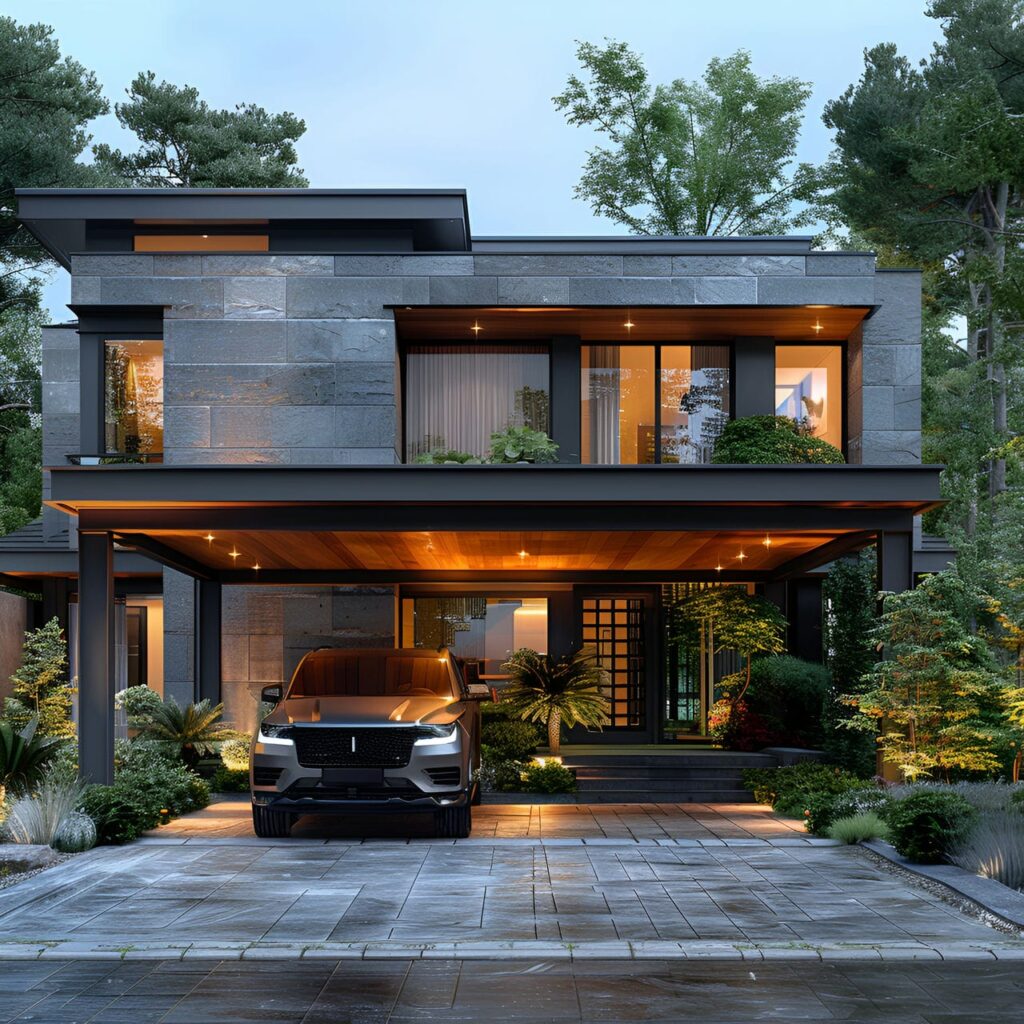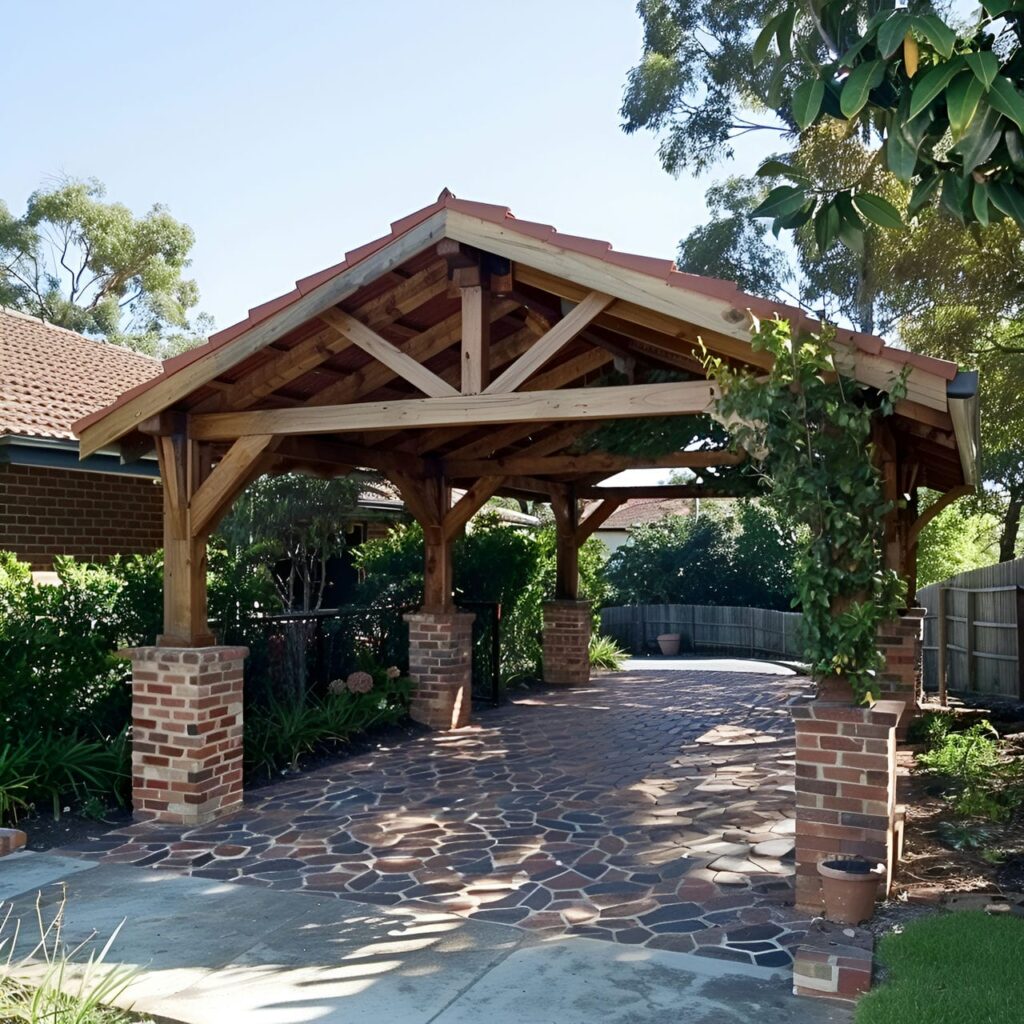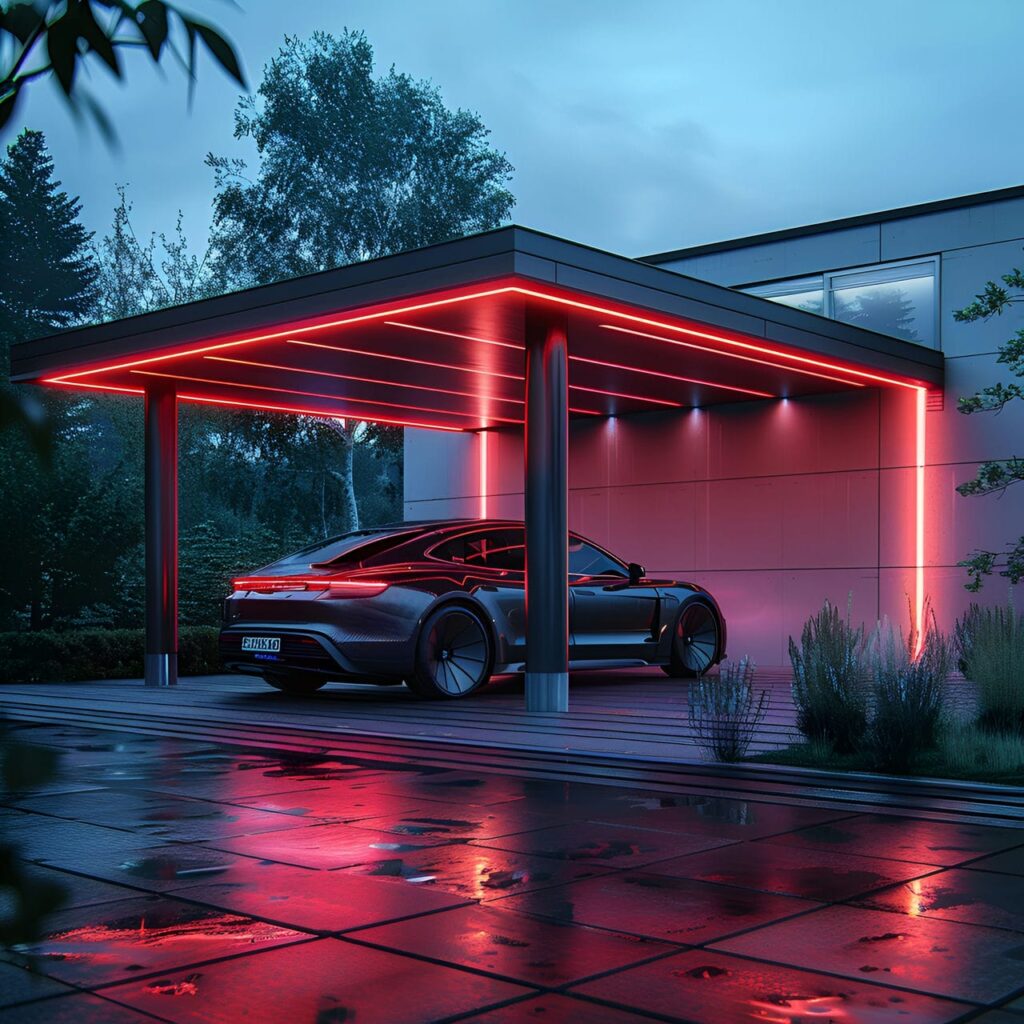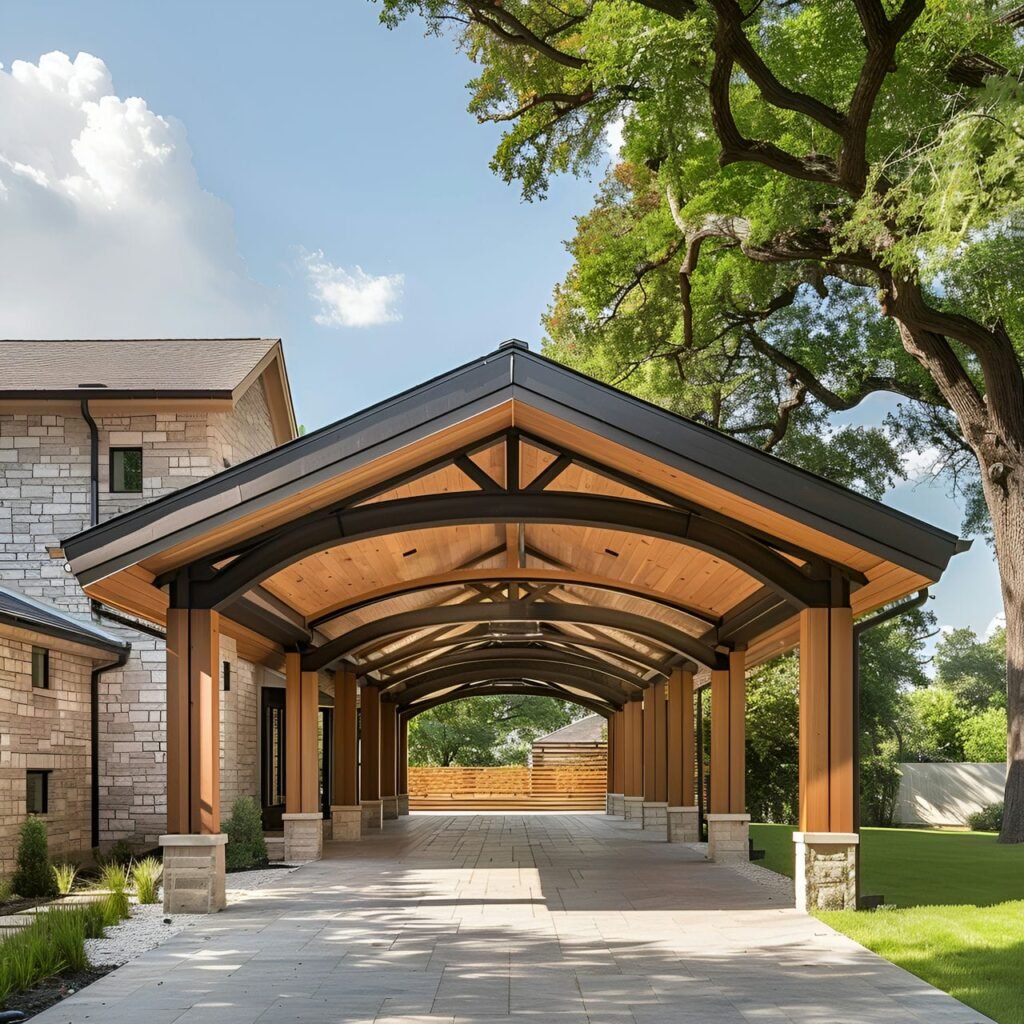Carports are essential in many residential properties that offer vehicle shelter and versatile utility spaces. Standard sizes range from 175 square feet (16 square meters) to 215 square feet (20 square meters) for typical residential carports, accommodating 1-2 vehicles, to over 430 square feet (40 square meters) for luxury versions that house multiple cars or recreational vehicles. The standard shape for carports is rectangular, maximizing space efficiency and vehicle accessibility. Commonly equipped with shelving units, workbenches, tool cabinets, bike racks, storage boxes, wall organizers, and utility cabinets, carports serve various functional needs beyond vehicle storage. The standard ceiling height for a carport is 25 square feet (2 square meters), ensuring most vehicles fit comfortably underneath. Popular colors for carports include gray, white, beige, blue, green, brown, and red. Energy efficiency in carports can be improved with solar panels, thoughtful layouts, strategic insulation, reflective materials, and efficient lighting. Hiring an architect for a carport renovation is only sometimes necessary, especially for minor updates. The decision to hire an architect depends on the scope of the upgrade. An architect’s services can significantly enhance the project’s value and functionality if it involves major transformations or specialized design elements. The time required to redecorate a carport varies, typically 1 to 4 weeks, depending on the project’s nature, material availability, contractor scheduling, and the complexity of the design. Homeowners face challenges in redecorating carports, such as budget constraints, design decision overwhelm, space limitations, material selection, weather considerations, finding reliable contractors, and balancing functionality with aesthetics.
What is the typical size of a carport?
A typical residential carport ranges from 175 square feet (16 square meters) to 215 square feet (20 square meters). The extended roof structure projects from the home or detached garage and allows 1-2 parked vehicles with room to exit conveniently. With only two to three open sides, dimensions span 13 feet (4 meters) to 16.5 feet (5 meters) wide and extend 11.5 feet (3.5 meters) to 20 feet (6 meters) long. Ceiling clearance height is standard at 7 feet (2.1 meters) from the paved driveway area to the carport roofline, so most vehicles fit underneath securely. The average carport measures 215 square feet (20 square meters) to 300 square feet (28 square meters). Ceiling heights remain average at 7 feet (2.1 meters) with widths spanning 16.5 feet (5 meters) to 23 feet (7 meters) for protecting 2-4 vehicles parked side-by-side. The extended length reaches up to 30 feet (9 meters) deep to maximize automobile, small boat, or recreational vehicle storage capacity entirely sheltered from exterior elements.
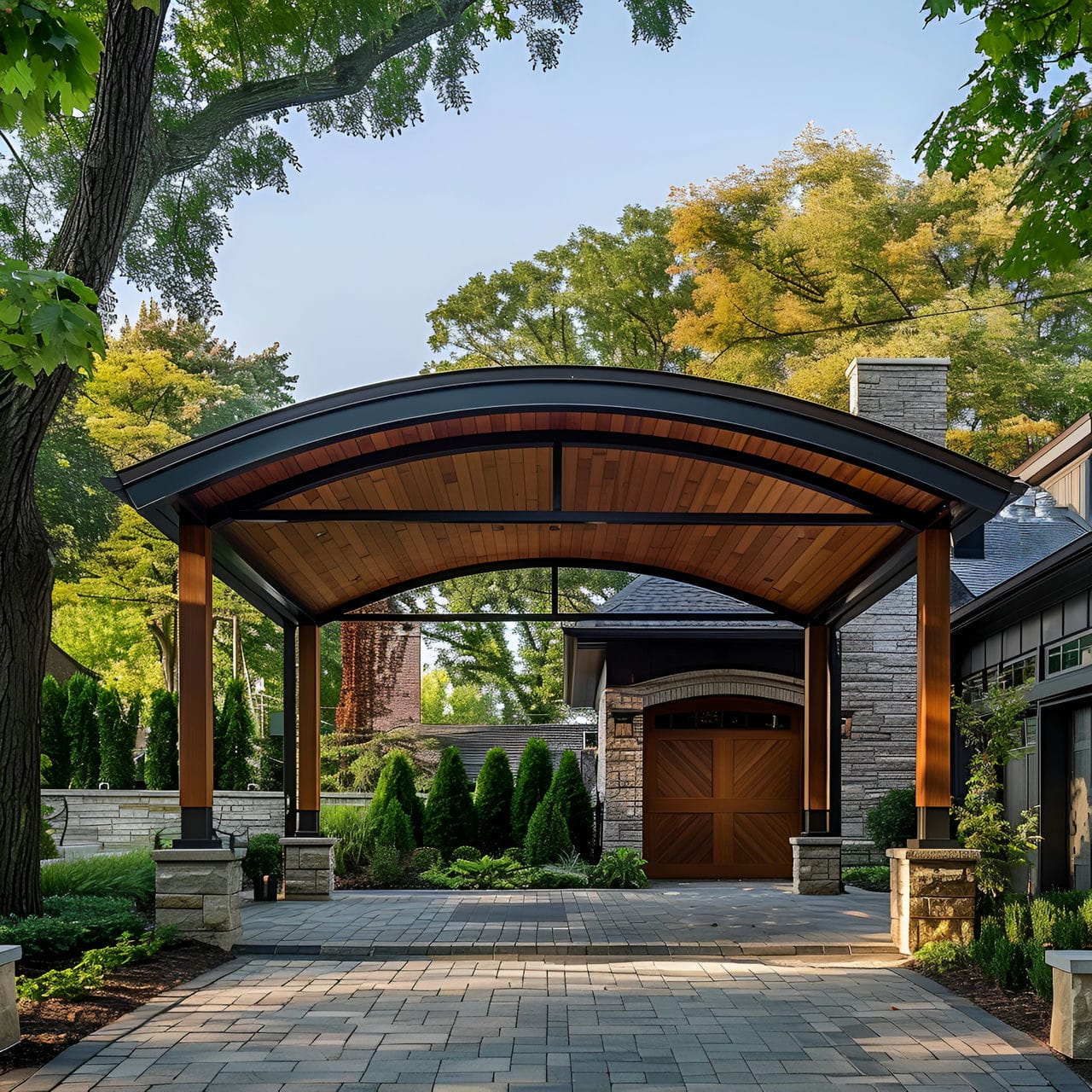
Oversized luxury residential carports exceed 430 square feet (40 square meters), providing covered parking for 6+ vehicles. At above 33 feet (10 meters) wide by 39 feet (12 meters) deep with full 7-foot (2.1 meter) clearance underneath, these grand carports often become integral extended wings of estate garages or aircraft hangars. Customized ceiling heights up to 13 feet (4 meters) accommodate RVs. Substantial terraces bordering elegant driveway turnarounds connect the impressive structures to the imposing home architecture.
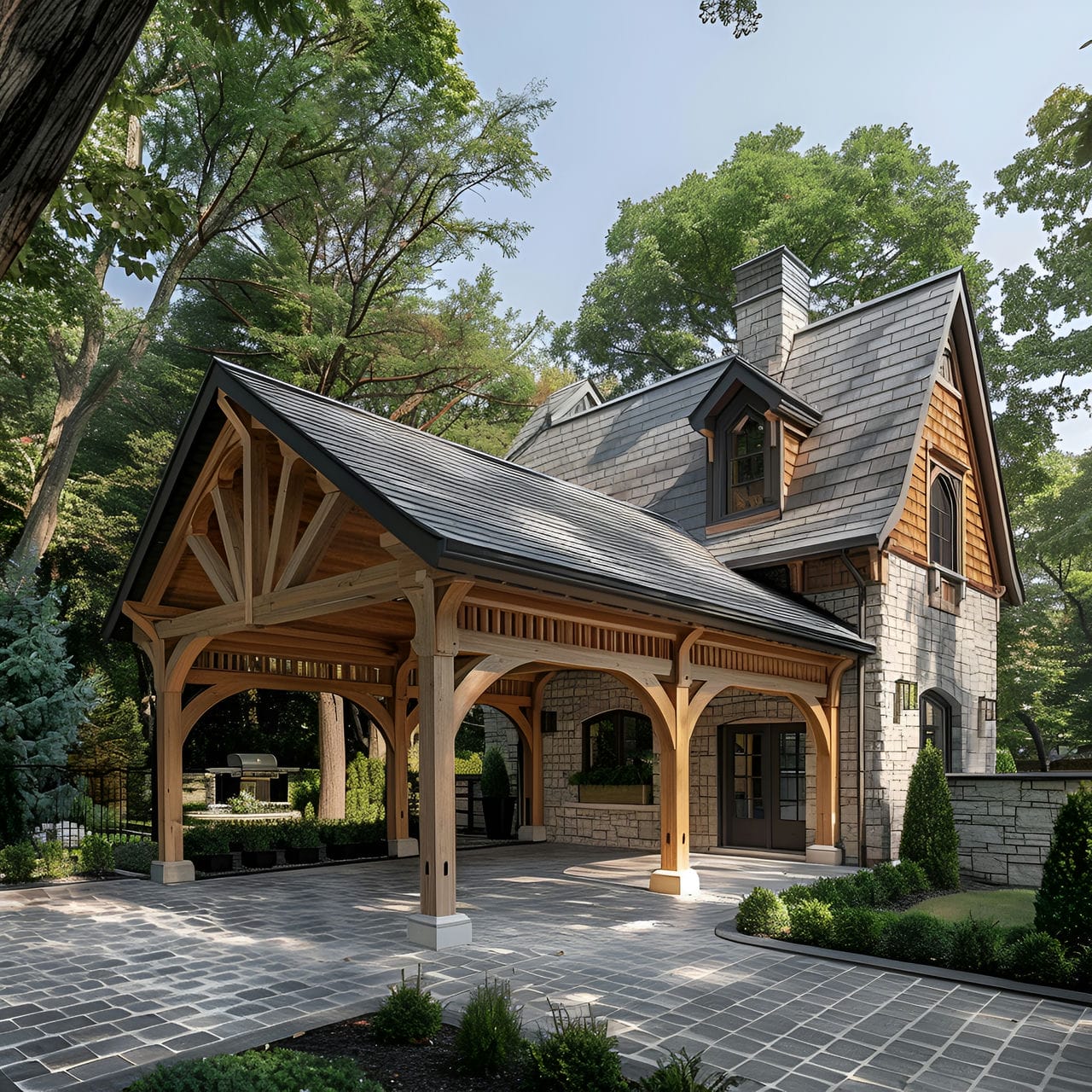
What is the use and purpose of a carport?
The purpose of a carport is to offer protection to cars from weather elements, easy accessibility, additional storage space, multifunctionality for various activities, enhancement to properties, cost-effectiveness, flexibility, and potential to increase property value. Firstly, the most fundamental use of a carport is to provide shelter for vehicles. This sheltering protects vehicles from environmental elements like sun, rain, snow, and hail, which can cause damage over time. Secondly, compared to garages, carports offer easier accessibility. Their open design allows for quick and convenient parking and access to vehicles, making them ideal for homeowners who frequently use their cars. Thirdly, carports are often used for storage. They can house vehicles, bicycles, boats, and gardening equipment. The open structure of carports makes them easily accessible for storing large items. Fourthly, many homeowners use carports as multifunctional spaces. They can serve as areas for outdoor activities, workshops, or even as additional living spaces during gatherings. Lastly, carports are a cost-effective alternative to building a full garage. They require fewer materials and labor to construct, making them an affordable option for vehicle protection. Certain types of carports are designed to be movable, allowing homeowners to adjust their location as needed.
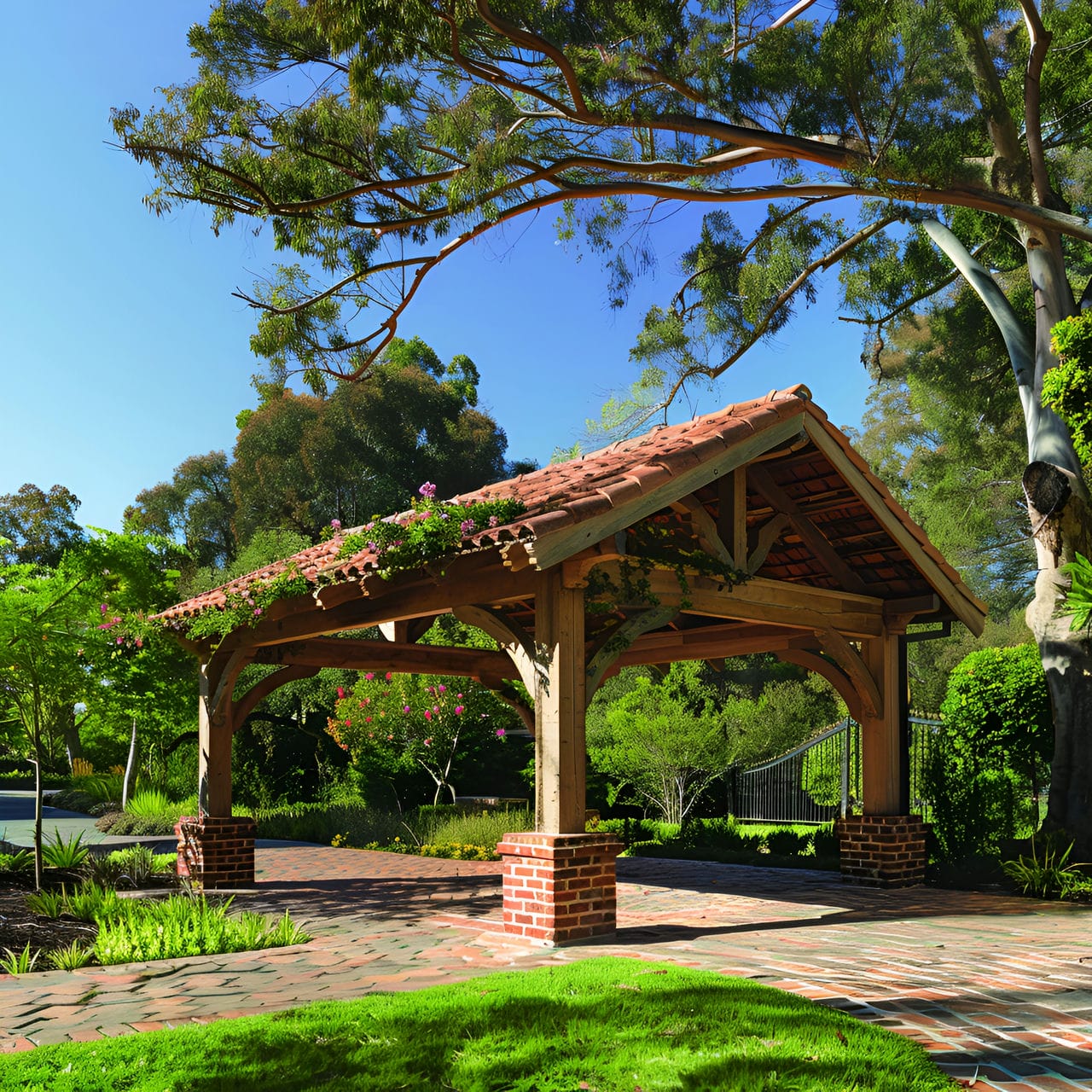
What is the typical shape of a carport?
The typical shapes of a carport are rectangular or square for maximum space efficiency. Rectangular carports have the longest walls, spanning 50 square feet (4 meters) to 75 square feet (7 meters), with wide entry openings directly facing existing driveways or garages, maximizing vehicle accessibility. Side depth ranges from 40 square feet (3.5 meters) to 60 square feet (5.5 meters). These positions support columns, storage cabinets, or shelving units out of primary traffic paths while maintaining an efficient covered area. Square carports measuring 50 square feet (4 square meters) to 60 square feet (5.5 square meters) concentrate centrally while retaining equal clearance around vehicles. Custom designs may incorporate sloped rooflines, extended dining terraces, or surrounding arches.
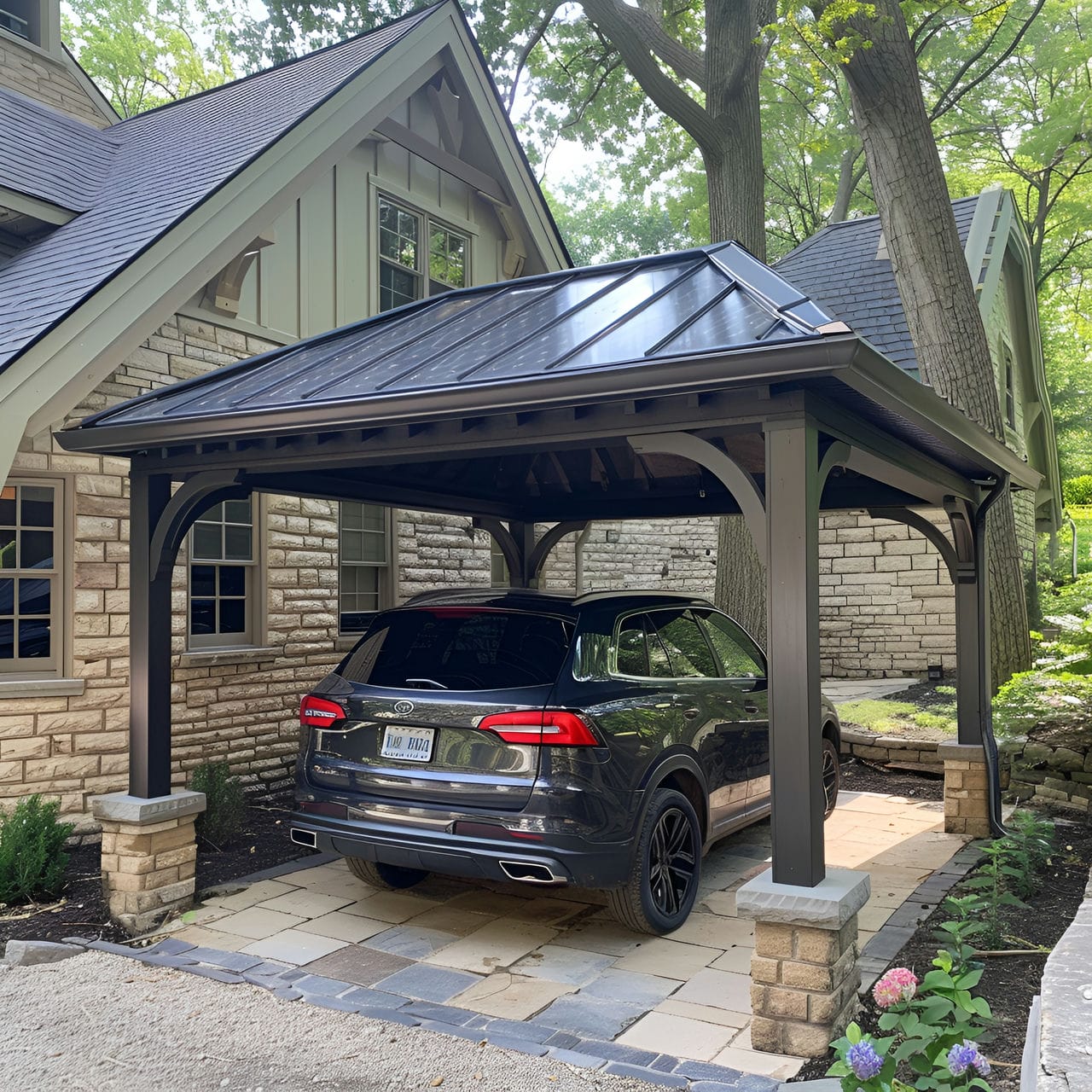
What furniture commonly equips a carport?
Listed below are the types of furniture commonly equip a carport:
- Shelving Units: Carports include shelving units for organized storage. This furniture offers space for storing tools, automotive supplies, and outdoor equipment. Made from materials like metal, plastic, or wood, shelving units in carports must be durable and capable of withstanding varying weather conditions if the area is not fully enclosed.
- Workbenches: Workbenches are frequent in carports, providing a sturdy surface for DIY projects or car maintenance. This furniture is made of solid materials like heavy-duty wood or metal, including features like built-in tool storage or clamps.
- Tool Cabinets: Tool cabinets are essential for organizing and protecting tools in carports. These furniture come in various sizes and materials, with options like lockable drawers for security. They help keep tools easily accessible and in good condition, preventing clutter and potential damage from exposure to the elements.
- Bike Racks: Bike racks in carports provide a secure and organized way to store bicycles. These furniture can be freestanding or wall-mounted, saving space and protecting bikes from theft or weather damage.
- Storage Boxes: Storage boxes in carports help keep various items organized and protected, like gardening supplies or sports equipment. These furniture, often made of durable plastic or metal, can be weather-resistant to safeguard contents against moisture and dust.
- Wall Organizers: Wall organizers maximize the use of vertical space in carports. These furniture can include hooks, shelves, and bins, providing customizable storage for tools, equipment, and accessories.
- Utility Cabinets: Utility cabinets in carports offer enclosed storage for more oversized items or supplies that need protection from dust and weather. This furniture can be tall and spacious, ideal for storing outdoor gear, automotive fluids, and more extensive tools.
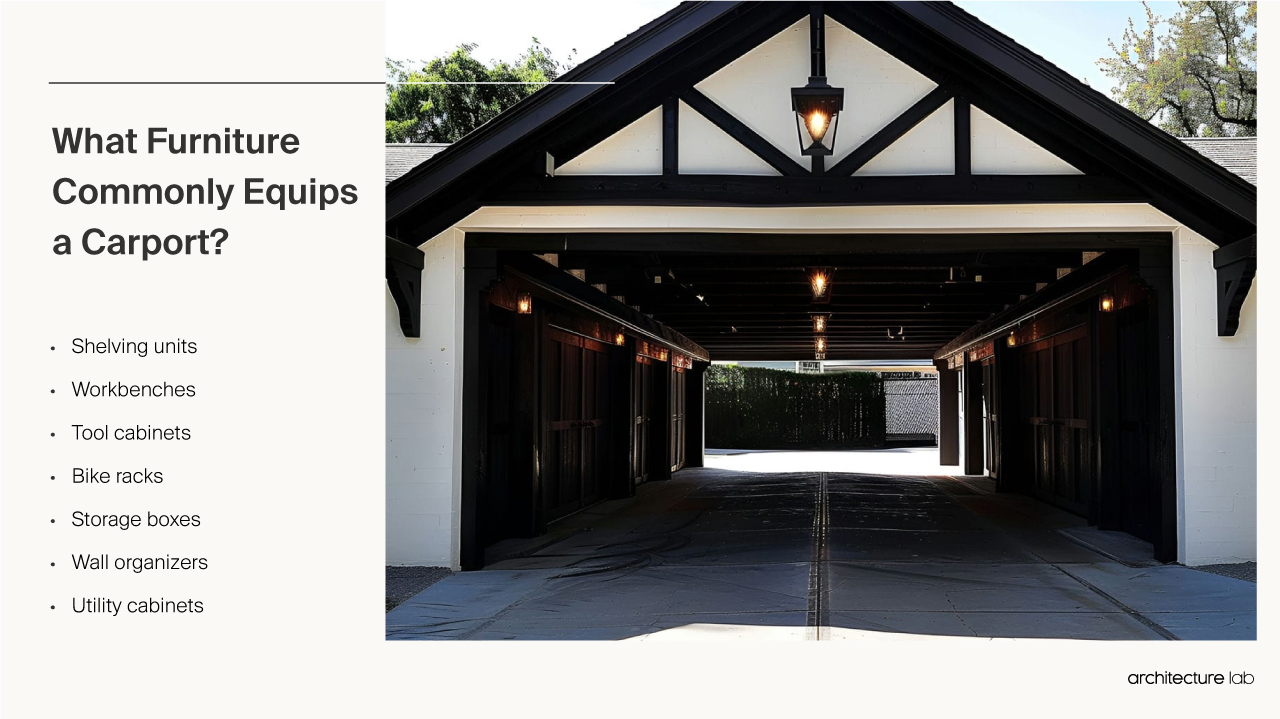
What is the normal ceiling height of a carport?
The normal ceiling height of a carport ranges from 25 square feet (2 square meters) to 30 square feet (2.5 square meters) to accommodate vehicle sizes. Average carport heights allow essential 7-foot (2-meter) clearance from the driveway area to the covered roofline so most typical vehicles fit securely while maximizing usable square footage. Contemporary SUVs and trucks require an additional 0.5 feet (0.15 meters) of clearance. High-end luxury residential carports elevate rooflines for proportions matching home architecture or to include functional second levels, resulting in heights starting at 30 square feet (2.5 square meters) to 35 square feet (3 square meters). Open-sided carports for covering vehicles remain closer to industrial standards at economical function-first heights averaging 25 square feet (2 square meters) to 30 square feet (2.5 square meters).
What colors are carports usually painted?
Listed below are the paint colors usually used in carports:
- Gray: Carports feature gray for their practical and modern look. This color hides dirt and marks well, making it a low-maintenance choice. Gray complements various house exteriors and is famous for its neutrality and contemporary appeal.
- White: White in carports is chosen for its clean and crisp appearance. White colors require more maintenance to stay clean but offer a bright, airy feel, matching most house colors.
- Beige: Beige carports blend with most home exteriors. This neutral color effectively hides dust and is less likely to show wear and tear over time. Beige provides a subtle, understated look, making it a practical and popular choice.
- Blue: Blue carports, especially in darker shades, are chosen for their durability and ability to hide scuffs and dirt. Blue can add a pop of color to the home’s exterior, ranging from navy for a bold statement to sky blue for a softer touch.
- Green: Green carports are less common but can complement homes with natural, earthy tones or those surrounded by greenery. Darker greens are practical for masking dirt, while lighter shades offer a unique and refreshing look.
- Brown: Brown carports are famous for their natural and rustic appearance. This color works well with homes featuring wooden or stone elements, creating a cohesive look. Brown is practical for hiding stains and requires minimal upkeep.
- Red: Red carports make a bold statement and are chosen to match specific design elements of the house. Red colors can add a distinctive look to the property. Darker reds are practical in maintenance and can create an eye-catching feature.
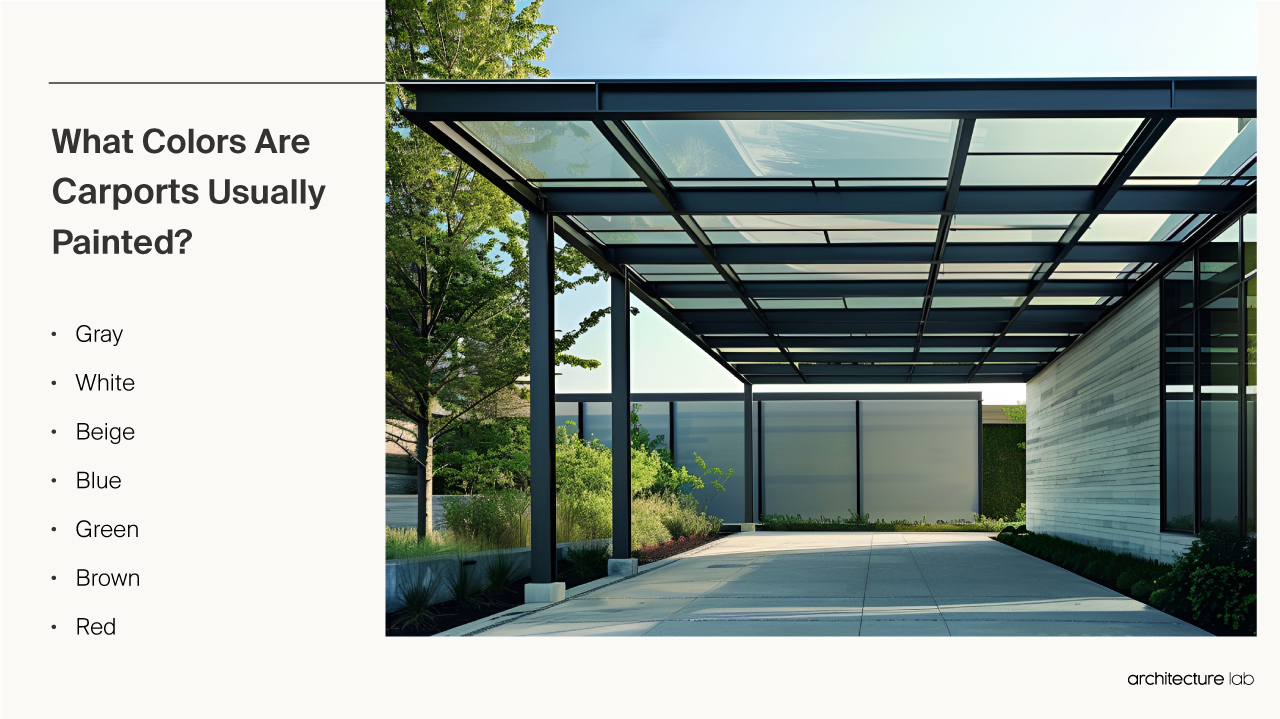
What makes the carport functional?
The carport is functional by protection from the weather, ventilation, covered parking, versatility for other uses, and the potential to improve home aesthetics and value. Firstly, a carport protects vehicles from the elements while allowing ventilation. The open sides allow air to circulate while the roof shelters cars, trucks, or other vehicles from rain, snow, sun, etc. This prevents issues like frost on windshields while avoiding an enclosed garage’s humidity and mildew risks. Secondly, a carport offers a covered parking space without significant renovation costs. Adding an entire garage can be expensive, but a simple carport structure is an affordable way to add protected parking. Thirdly, carports are versatile and can serve multiple purposes beyond vehicle parking. The search results gave examples like using a carport as a play area for kids, a patio cover, extra storage, a workspace, etc. The roof and open sides can shelter a range of activities. Lastly, carports can improve aesthetics and home value with customizable design features. They can use roof materials and colors to match the home and increase curb appeal.
How is energy efficiency achieved in a carport?
Energy efficiency is achieved in a carport by choosing solar panels, thoughtful layout/divisions, strategic insulation, reflective paints/materials, and efficient lighting. Firstly, installing solar panels on the carport roof allows it to generate clean, renewable greenhouse energy from sunlight. The solar carport feeds this energy into the home or business to reduce electricity costs and environmental impact. Secondly, the carport’s shape, size, and layout can impact energy efficiency. Dividing large carports into sections allows better temperature control with separate HVAC units. Thirdly, insulation helps regulate interior temperatures. Spray or rigid foam boards add insulating value to the carport walls and ceiling. Proper insulation prevents rapid temperature fluctuations inside the structure. Fourthly, exterior color choice affects solar heat gain. Light or reflective finishes reflect more sunlight to maintain cooler interior temperatures in hot climates. Darker colors absorb more heat, which can be helpful in colder regions. Lastly, energy-efficient lighting like LEDs can illuminate the interior using minimal electricity. Automated controls can turn lighting on and off based on motion detection or schedules to limit energy use further.
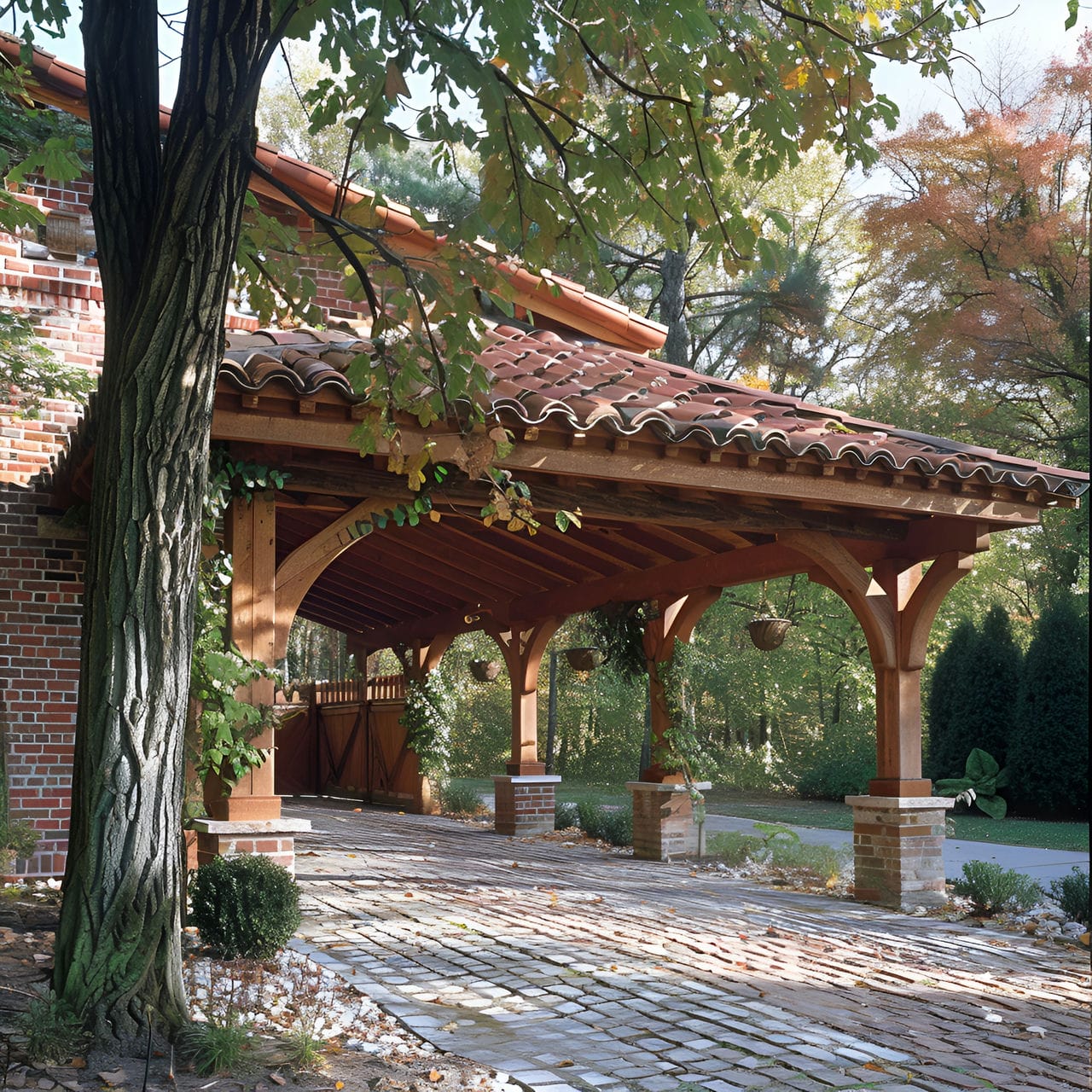
How much does it typically cost to renovate a carport?
The average cost to renovate or expand an existing 175 square foot (16 square meter) to 300 square foot (28 square meter) residential carport falls between $3,000 (€2,700, £2,300) to $7,500 (€6,900, £5,900). Cosmetic updates like fresh neutral paint on wall connections to the home run closer to $3,000 (€2,700, £2,300). Structural changes like altering the overhead rooflines, layout expansions, or foundation/drainage updates for added vehicles require specialized contractors driving prices toward $7,500 (€6,900, £5,900). Sealing and restriping the concrete is below average at $1,500 (€1,350, £1,150). Any electrical or exterior sconce lighting enhancements fall between $500 (€450, £395) to $2,500 (€2,300, £1,900). For contemporary carports with integrated top-tier garage mechanics like customized cabinetry, epoxy floors, infrared heating, or audio, costs can reach $15,000 (€13,800, £11,800). Typical carport improvement budgets range from $3,000 (€2,700, £2,300) to $7,500 (€6,900, £5,900). Massive overbuilds to existing structures or architecturally distinct new guest pavilions would increase bottom lines past $30,000+ (€27,500+, £23,500+).
What factors affect the carport renovation?
Listed below are the factors that affect the carport renovation:
- Budget: The budget affects carport renovation decisions. It determines the extent of changes possible, from essential cosmetic updates to complete structural overhauls. A limited budget might restrict the choice of materials and the scale of the project.
- Existing Structure: The current state and design of the carport influence the renovation process. Structural limitations, existing damage, or specific architectural features can dictate the scope of work. Renovations must often work around these conditions, impacting design choices and potential upgrades.
- Purpose and Functionality: The intended use of the carport impacts renovation decisions. Each purpose requires different features and layouts for parking vehicles, storage, or workshop space. This affects choices in size, materials, and additional elements like shelving or insulation.
- Weather and Climate: Local weather and climate conditions are crucial in carport renovations. In areas with harsh weather, durable materials and protective features like insulation and waterproofing become essential. The design may also need to account for snow load, wind resistance, and drainage.
- Material Availability: The availability of renovation materials influences the timeline and cost. Local availability of desired materials can expedite the project and reduce costs, while special orders or materials shipping can add time and expense. Material choices also impact the carport’s durability and maintenance needs.
- Zoning Laws and Regulations: Local and building regulations are critical in carport renovations. Compliance with these laws affects design, size, and structural changes. Failure to adhere can lead to legal issues or the need for costly modifications post-renovation.
- Aesthetic and Design Preferences: Personal aesthetic preferences and the design of the existing house impact carport renovation. The goal is often to create a cohesive look with the main house.
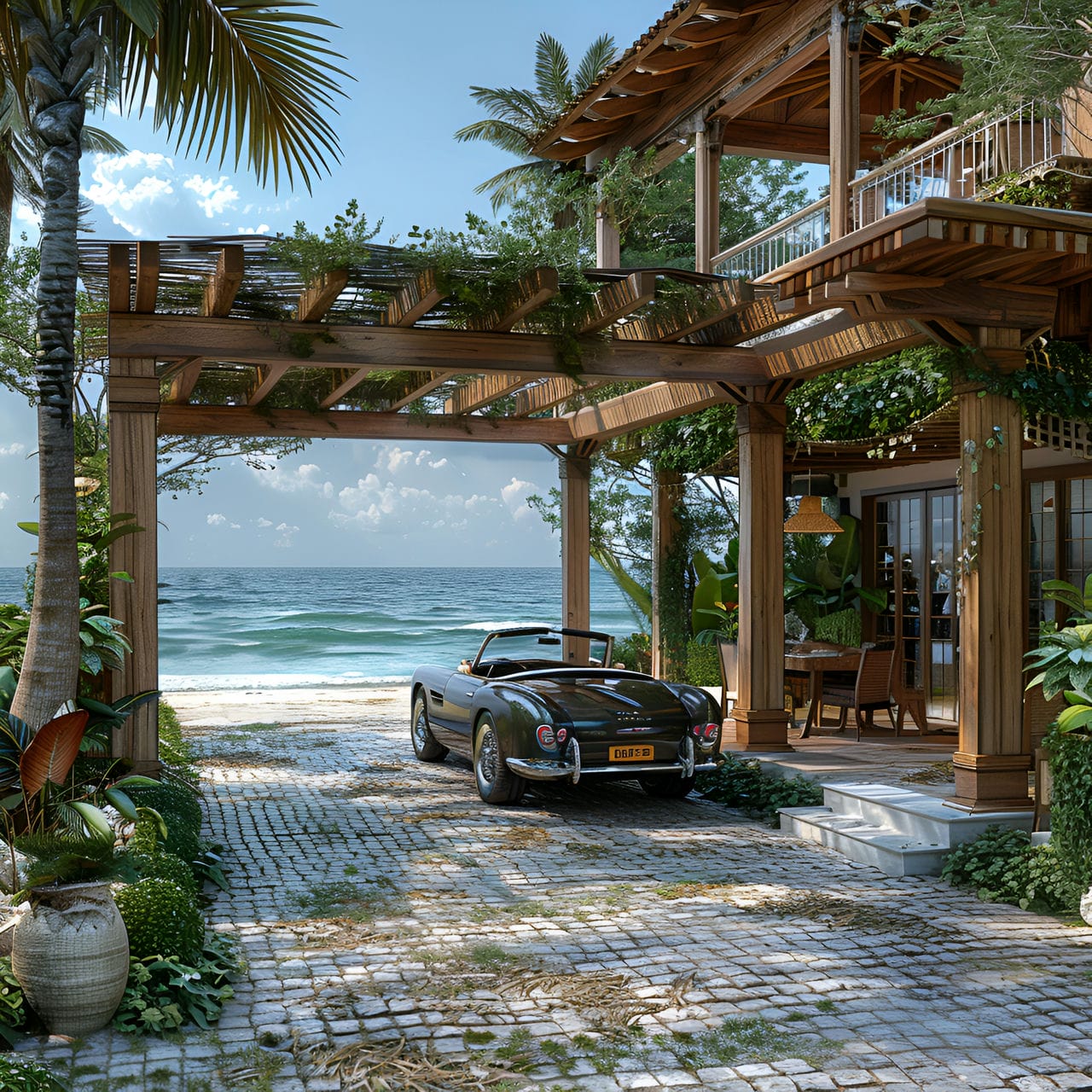
Is an architect required to renovate a carport?
No, an architect is not required to renovate a carport, but it is highly recommended. For simple renovations, a homeowner might manage the project independently or with the help of a general contractor. Suppose the renovation includes significant structural changes, such as expanding the carport, altering its foundational support, or converting it into a garage or living space. In that case, the expertise of an architect can be invaluable. Architects provide professional guidance on design, ensure compliance with building codes, and offer creative solutions for space utilization and aesthetic enhancements. Their involvement becomes more crucial in complex renovations where specialized knowledge of architecture and design is beneficial.
How can an architect help you upgrade a carport?
Listed below are the ways that an architect can help an owner upgrade a carport:
- Design Expertise: An architect can provide specialized design expertise for upgrading a carport. They offer creative and functional design solutions tailored to the homeowner’s needs and preferences. This includes optimizing the use of space, suggesting aesthetic improvements, and ensuring the new design complements the home’s existing structure.
- Structural Analysis: Architects know how to analyze the existing carport. They can assess its condition, identify potential structural issues, and recommend necessary reinforcements or modifications. This ensures the upgraded carport is appealing but also safe and durable.
- Navigating Regulations: Navigating local building codes and regulations is a complex task where architects can be invaluable. They understand these requirements and can ensure that the carport upgrade complies with all local zoning laws, building codes, and permits needed for construction.
- Material Selection: Architects can assist in selecting the suitable materials for the carport upgrade. They can recommend durable and aesthetically pleasing materials ideal for the climate while considering budget constraints.
- Project Management: Architects can oversee the upgrade process, providing project management services for the carport. This includes coordinating with contractors, managing timelines, and ensuring the project stays within budget.
- Energy Efficiency and Sustainability: Architects can incorporate energy-efficient and sustainable design principles into the carport upgrade. This may include recommendations for eco-friendly materials, efficient lighting, and other sustainable practices.
- Customization: An architect can offer customization options unique to the homeowner’s requirements. An architect can design a carport tailored to the homeowner’s needs and lifestyle by adding workspace areas or including vehicle charging stations.
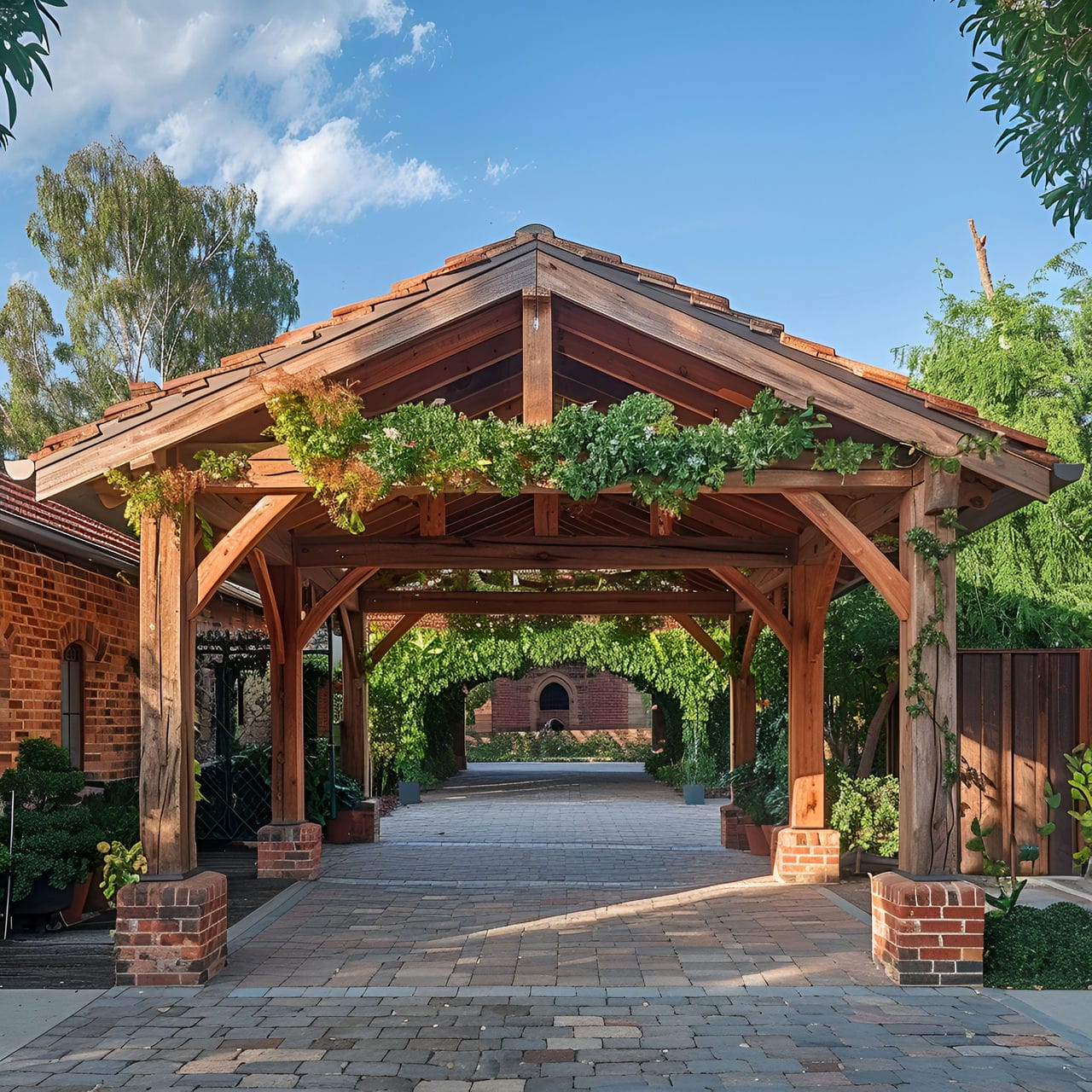
How much does it cost to hire an architect to renovate a carport?
The average cost to hire an architect to design a residential carport renovation ranges from $800 (€720, £600) to $2,500 (€2,300, £1,900) based on the scale and customization. Most architects charge $100 (€90, £75) to $175 (€155, £135) hourly. Adjusting a 175 square foot (16 square meters) carport with refreshed paint totals 6-10 hours for fees of $800 (€720, £600). Updating a 215 square foot (20 square meters) structure while working within structural parameters by incorporating new skylights, storage closets, or an extended footprint requires closer to 15-20 architectural hours averaging $1,500 (€1,350, £1,150). Top-tier designers create contemporary carports integrated seamlessly with home architecture through shared high-end finishes and details, including climate control charging stations or audiovisual streaming charging $2,500+ (€2,300+, £1,900+). Their elaborate plans demand 20-30 engineering hours. Minor carport improvement concepts run $800 (€720, £600) to $1,500 (€1,350, £1,150), while extensive layout reconfigurations allowing signature customization match required work time between $1,500 (€1,350, £1,150) to $2,500+ (€2,300+, £1,900+). Simple plans cost $100/hour (€90/per hour, £75 per /hour), while structural proposals increase prices.
Is it worth it to hire an architect to upgrade a carport?
Yes, hiring an architect to upgrade a carport can be worth it, particularly for complex or significant upgrades. An architect brings professional expertise in design, ensuring that the upgrade is pleasing but functional and efficient. They can provide innovative space utilization solutions, integrate the carport with the home’s design, and address structural challenges. An architect’s knowledge of local building codes and regulations ensures that the upgrade complies with all legal requirements, which is crucial for structural modifications. Their transformation guidance involves converting the carport into a garage or living space or adding sophisticated features like automated doors or energy-efficient lighting.
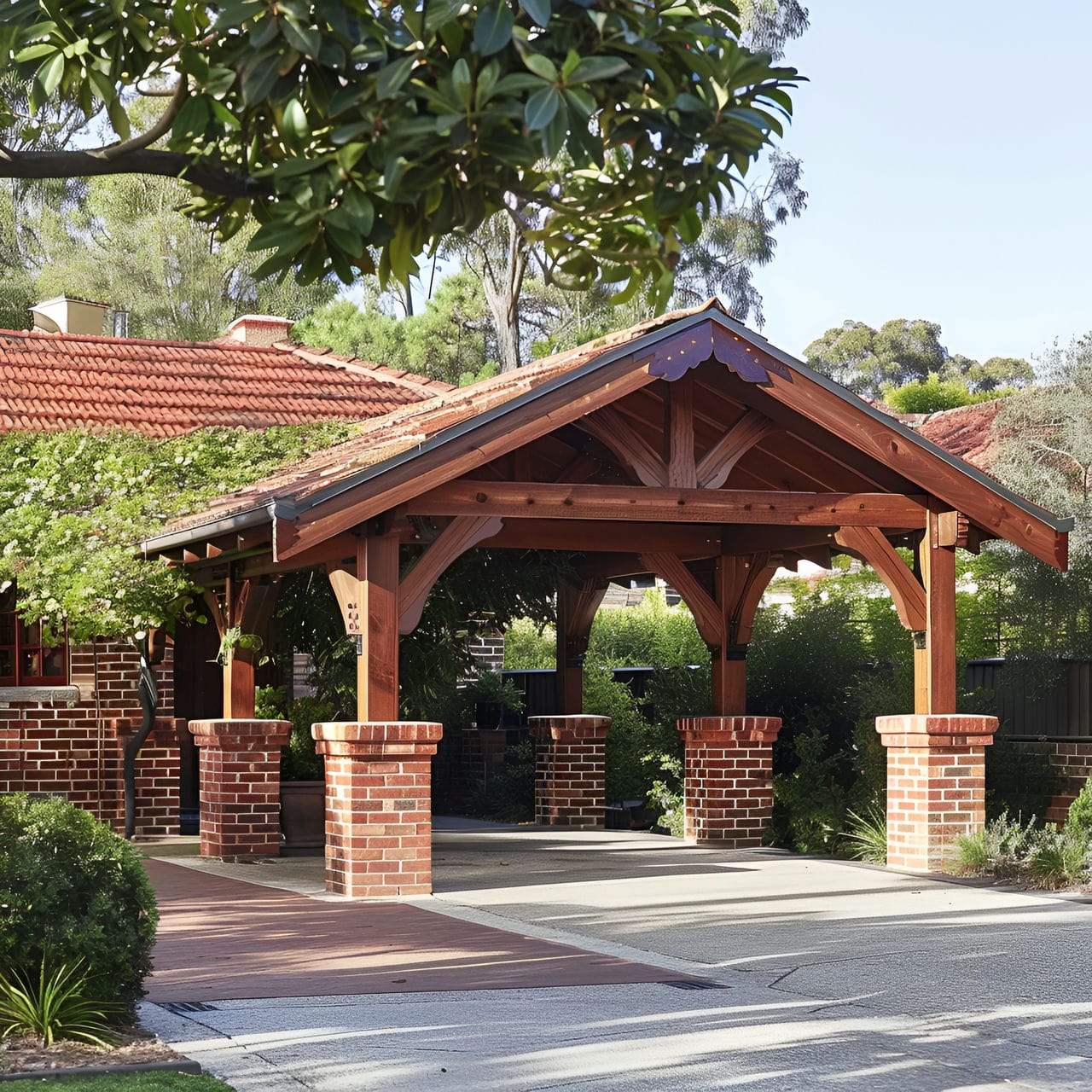
How long is needed to redecorate a carport?
To redecorate the carport, a timeframe of 2 to 3 weeks is needed. Firstly, if the redecoration involves basic tasks like repainting or minor cosmetic updates, it can be completed within 1 to 2 weeks. This includes preparation, application, and drying times. Secondly, adding new features such as lighting fixtures or storage units extends the project to 2 to 3 weeks, factoring in installation and setup times. Thirdly, more extensive redecorations, such as replacing the roofing, installing new flooring, or custom-building storage solutions, can extend the timeline to 3 to 4 weeks. Lastly, the availability of materials and furnishings can impact the timeline; readily available items keep the process on a shorter schedule, while custom or special order items can add time.
What are the struggles of the homeowner to redecorate a carport?
Listed below are the struggles of the homeowner to redecorate a carport:
- Budget Limitations: Homeowners often face budget limitations when redecorating a carport. Costs can escalate with structural changes, high-quality materials, or if unexpected issues arise during renovation, requiring careful financial planning and prioritization.
- Design Decision Overwhelm: Choosing the right design for a carport redecoration can be overwhelming. This indecision can lead to delays or dissatisfaction with the outcome.
- Space Constraints: Maximizing limited space is a common struggle in carport redecorations. Homeowners must find creative ways to utilize the available space efficiently, primarily if the carport serves multiple purposes like parking and storage.
- Material Selection and Availability: Choosing suitable materials that are durable, pleasing, and within budget can be a hurdle for a carport. Homeowners also face the challenge of material availability, as delays in obtaining suitable materials can prolong the project and increase costs.
- Weather Considerations: Weather conditions impact carport redecoration. The need for weather-resistant materials and construction methods to withstand local climate conditions can complicate the redecoration process and limit material and design choices.
- Balancing Functionality and Aesthetics: Homeowners struggle to balance functionality with aesthetics when redecorating a carport. The space must be practical and visually appealing for its intended use, such as vehicle storage.
